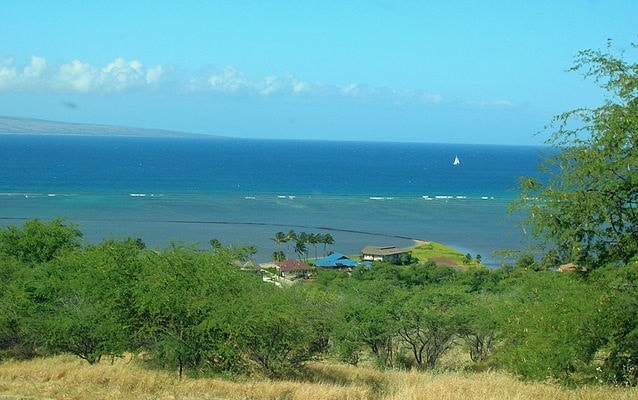Last updated: August 16, 2019
Place
Hokukano-Ualapue Complex, HI

Photo by Forest & Kim Starrderivative work: W Nowicki, CC BY 3.0
Hokukano-Ualapue Complex, located in the District of Kona on the Island of Molokai, is one of the most important archeological and architectural areas in the Hawaiian Islands. The complex consists of seven heiau (places of worship) – Kukui, Pu'u 'Olelo, Kaluakapi'ioho, Kahokukano, Pakui, Kalauonakukui, and Iliiliopae, and two fishponds; Keawanui and Ualapue. The heiau and fishponds at Hokukano-Ualapue offer spectacular views of the southeast coast of Molokai as well as the neighboring islands of Maui, Lanai, and Kaho'olawe. The District of Kona contains more heiau and fishponds than any other comparable area in the Hawaiian Islands, and the engineering advancements, religious and political power structures, and economic control that developed on Molokai are well represented at this site.
Early Hawaiian shrines were simple and constructed by families and small communities. With expansion, population growth, and changes in religion, social organizations became more complex and large heiau were constructed for public ceremonies. In general, the ali'i (chiefs) worshiped four major gods in these ceremonies: Lono (peace, agriculture, fertility), Kane (the creator and ancestral deities), Kanaloa (the ocean, healing and general well-being), and Ku (war). Commoners worshipped individual family gods at private family shrines and worshipped the four major gods under the direction of high priests.
Ancient Hawaiians had many types of heiau, each with their own distinct function and use by particular segments of society. Heiau ranged in size from single upright stones to massive and complex structures. Larger heiau were built by ali'i, but the largest and most complex, the luakini heiau (sacrificial temple), could only be constructed and dedicated by an ali'i 'ai moku (paramount chief of an independent chiefdom or island). Luakini heiau were reserved for rituals involving human or animal sacrifice and were generally dedicated to Ku. Rituals performed at aluakini heiau highlighted the ali'i 'ai moku's spiritual, economic, political, and social control over his lands and his authority over the life and death of his people.
Kukui Heiau (20,400 square feet) and Kalauonakukui Heiau (9,600 to 10,625 square feet) are thought to have been agricultural heiau possibly dedicated to Lono. Pu'u 'Olelo Heiau is approximately 10,730 square feet in size, has an enclosed courtyard, and was most likely a luakini. Kaluakapi'ioho Heiau, at approximately 4,464 square feet, is believed to have been associated with Kumuko'a, an important chief of the district where the heiau is located. Kahokukano Heiau (16,800 square feet), thought to be a fish heiau, is associated with Kaohele, a famous warrior and athlete, and Kumuko'a, a Molokai chief. Pakui Heiau (15,725 square feet) appears to have been a luakini. In addition, Pakui Heiau is thought to have been a pu'uhonua (place of refuge) used by people seeking asylum in times of war or fleeing punishment for violating kapu (religious, political, and social laws). Iliiliopae Heiau is possibly the oldest religious site on Molokai and is the second largest heiau in the Hawaiian Islands. Built sometime in the 1300s, this large structure was a fortress school for kahuna (priests, sorcerers, magicians, ministers, and master craftsmen). Over time, Iliiliopae Heiau served various functions based on changing religious practices and political regimes and at various times was aluakini heiau dedicated to Ku and a heiau dedicated to Lono. It probably remained in use until the early 1800s.
The earliest date for the construction of fishponds in Hawaii is estimated to be sometime around 1200 AD. Hawaiians were the only ancient Polynesian people to move beyond the simple catching of fish in traps to more intensive fish production and cultivation. Fishponds were the property of ali'i and were symbols of the chiefly right to conspicuous consumption and ownership of coastal marine resources. Fishponds generally consisted of two major types: shore and inland. Both Keawanui and Ualapue are examples of shore ponds, built at natural curvatures of the ocean's shoreline. They each contain a seawall that, with the shoreline, creates a pond enclosure. Hawaiian fishponds were primarily feeding areas in which algae was cultivated. Fish, predominantly mullet, would enter a pond through a mäkähä (sluice gate), feed on algae, and eventually grow too large to swim back through the small gaps of the mäkähä. The large fish would gather near the gate allowing the Hawaiians to easily catch and harvest them by hand or with nets. Fishponds generally had a hale kia'i or guard house, used as a shelter by the kia'i loko (pond keeper) while on poaching patrol. Fishing shrines and net houses were also located near the ponds. Prior to 1830, there were over 440 fishponds in the Hawaiian Islands, most located on Molokai, Kauai, and Oahu.
Keawanui fishpond is the largest and probably the oldest extant fishpond on Molokai, at one time encompassing 73 acres with a seawall averaging 6 to 7 feet in width. Constructed around 1575, by ali'i 'ai moku Lohelohe, it remained in operation until the early 1960s. In recent years Keawanui has been restored and is used as a site to teach schoolchildren about native Hawaiian culture and fishpond technology.
Ualapue fishpond originally consisted of 22 acres with a seawall 8-19 feet wide constructed of coral and basalt. The date the pond was built is unknown, but it was in continuous use until the tsunami (tidal wave) of 1960 damaged the wall and destroyed the two mäkähä. Historically, Ualapue was noted for the fatness of its mullets and was considered one of the best fishponds on Molokai.
Hokukano-Ualapue Complex is located off of Hawaii Route 450 (Kamehameha V Highway) in Ualapue on Molokai, HI.
